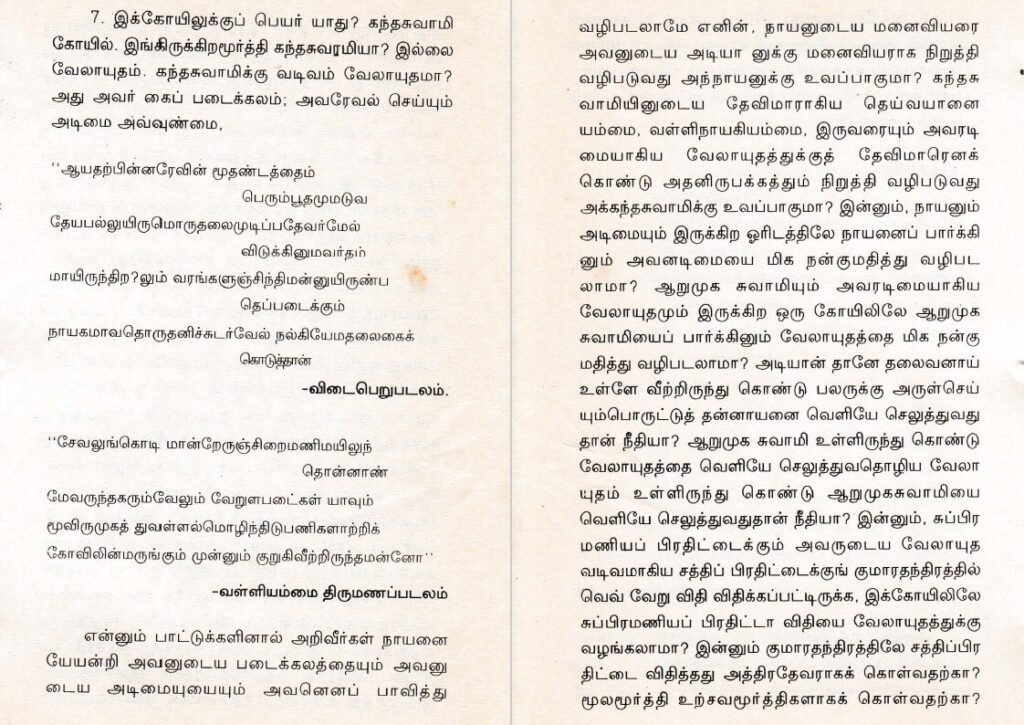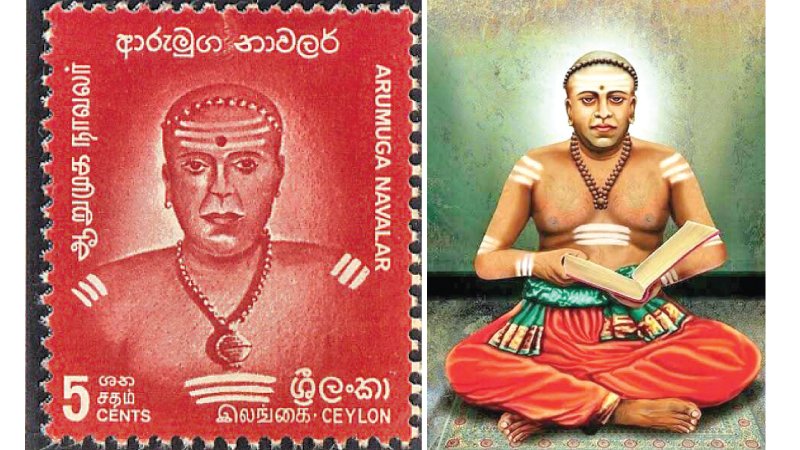I have often wondered how to express this: In what concrete way can you become better as a result of reading शास्त्र-s or any other sacred texts? An insight dawned upon me when I was reading one of the writings of आऱुमुग नावलर् – the legendary शैव-महाविद्वान् of Jaffna. The piece in question is titled “नल्लूर्-कन्दस्वामि-कोविल्” (नल्लूर्-स्कन्दस्वामी-आलय). It is essentially a long diatribe in the form of a letter, addressed to the administrators in charge of the स्कन्दस्वामी temple of नल्लूर् (Nallūr) in the year 1875. The piece essentially tears apart every deviation & ill-practice in the temple. श्री-नावलर् was a feisty scholar, known for his fierce loyalty to शास्त्र, formidable scholarship, his conscientiousness & for wearing his heart on his sleeve.
This letter (actually, there is a second such letter as one letter was probably not enough to contain the passionate criticisms & righteous indignation of नावलर्!!) runs for a good 40 pages, with 50 numbered points. We shall see one of those points shortly. To give you all some context first, every आगमिक temple (as established in the south & by extension, Jaffna in Lanka, which is culturally part of the दक्षिणाभारत-मण्डल) has two important मूर्ति-s; namely, 1. The मूलमूर्ति & 2. The उत्सवमूर्ति. The मूलमूर्ति is the deity in the innermost sanctum, the गर्भगृह. It is, by right, immovable (अचलमूर्ति).
The उत्सवमूर्ति is the movable “version” of the मूलमूर्ति, who gets taken around in processions around the town or village. Hence, he is a movable मूर्ति. All these forms are not crafted arbitrarily. Creativity has its place, but within the confines of the presiding आगम/तन्त्र of the temple. Now, we come to the specific issue of the नल्लूर्-कन्दस्वामि-कोविल्. What was the problem with this temple? In this temple, the मूलमूर्ति & उत्सवमूर्ति are both the वेल् (vel), the weapon that is almost always in the hands of स्कन्द in temples, as we see below:

Now, when नावलर् points this, the first issue that came to my mind was the idea that मुरुगन्/Murugan (that is, स्कन्द) & his वेल् (the शक्ति-आयुध) are installed (प्रतिष्ठित) with separate प्रतिष्ठा-विधि a
And नावलर् does cite this technical argument, but only after he unleashes a far more piercing take. Something that reveals his profound sensitivity in divine matters that only comes because of a genuine devotion towards sacred scriptures.
Now, again, the reader must have a little more context. The temple was built by the local शैव community, who had historically professed allegiance to the शैव religion as explained in the various आगम-s & the rich तमिऴ् (tamizh) शैव canon. This tamizh Canon includes the peerless text of the कन्दपुराणम्, a 17th century tamizh पुराण on स्कन्द written by कच्चियप्प (कश्यप) शिवाचार्य, an अर्चक of the कुमारकोट्टम् (kumārakoṭṭam) shrine for स्कन्द in काञ्चिपुरम्, TN.
It is not just a work containing the stories of the deity मुरुगन् but is filled with many refrerences to rituals & even philosophical concepts.+ Given that the author was a revered अर्चक who was a master of the सिद्धान्तागम rites, if there is any book that should be revered by one purporting to be a devotee of स्कन्द & also following the सिद्धान्त, that book is the कन्दपुराणम्. So, why do I say all this?
नावलर् quotes two passages from the कन्दपुराणम् including a particularly delightful verse, where the rooster, the chariot, sheep, peacock, the वेल् weapon & स्कन्द’s troops all carry out works for the 6-faced god after his marriage with वळ्ळि-देवी. And this is where नावलर् offers us a stunning insight, that shows how sensitive his devotion really was.
He raises the following question: “To have the two wives of the master, देवसेना-माता & वळ्ळि-माता standing on both sides of his servant (who carries out works for him), the वेल्-weapon as if they were the latter’s देवी-s; would this be pleasing to that master, that स्कन्द?!!”
The original here:

And it occured to me that I never saw it this way! His scholarship shows in the way that he was able to quote an appropriate verse from the lengthy कन्दरुराणम् but his devotion shows in the way that he applies this learning.
Most of us may see a वेल् in the place of स्कन्द & not be disturbed by it at all. “Ah, this is just the unique way they do it!” or “Why are you so rigid?!” may be our reactions. I may think, “there are separate procedures for their प्रतिष्ठा”.
But how many will pick up on the fact that such an arrangement violates the sanctity of the देव-पत्नी relationship? This is the fruit of real भक्ति & reading sacred texts with deep reverence.
This is the real fruit of learning sacred texts. They allow us to develop a better intuition as to what is appropriate & what is jarring. When we, like नावलर्, read with proper devotion a verse that portrays the वेला weapon as a servitor carrying out works for the sake of स्कन्द & his wives, we get the following insights:
- The वेल् has its own individuality. It is not स्कन्द himself.
- It exists in a state of subservience to both स्कन्द & his wives.
When we internalize these principles, we develop a genuine appreciation for what is right & what is wrong. How might many of us see it instead? We might not see the weapon as an individual, as another deity.“Oh, it’s just a symbol of स्कन्द. They are one; all is one”. I call this the masāla-advaita perspective. It masks intellectual laziness & a lack of respect in semi-profound language.
Real devotion should instead require some effort & rigor on our parts. We care to make distinctions where they matter & not lump them into some nebulous oneness.
I will add the two verses that नावलर् cited from कन्दरुराणम् with commentaries for those interested to know them.


*वेल् Some seem to feel that the great शैव scholar is very rigid. Honestly, lay Hindus should exercise some basic self-awareness & humility & think mouthing off about महाविद्वान्-s; especially one who gave his life to नैष्ठिक-ब्रह्मचर्यम् to combat missionaries & guard धर्म. To such people, I will ask this: In daily life, can you bear your individuality being eroded, ignored or conflated with that of another? Will you stand your marks/scores in school being given away to another, let alone have your spouse being mistaken as that of another? If you are that sensitive (& rightly so) about yourself, is it not true devotion to exercise such sensitivity for our deities? It is that profound sensitivity that the great नावलर् demonstrates here:
No, नावलर् is not rigid. You just don’t care at all.
